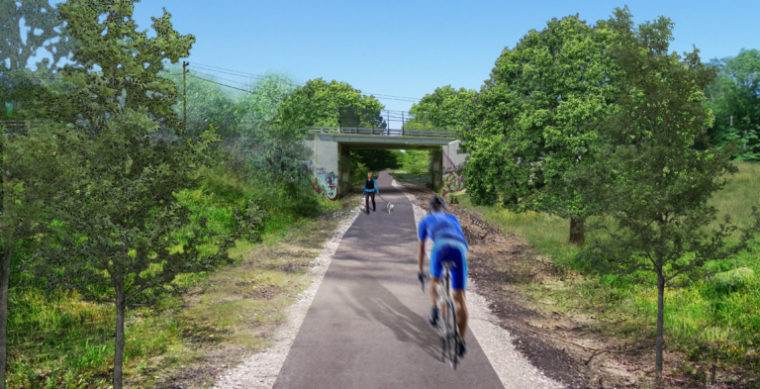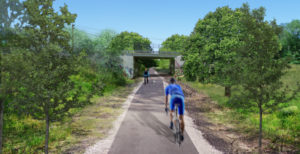
Bike trails and greenway projects no longer represent inconsequential amounts of funding. In fact, these types of projects now represent a spending impact that exceeds $10.6 billion annually. Data indicates trail development projects that encourage hiking, biking, and walking result in numerous benefits and can be credited for about $20 billion in health cost savings.
Between 2021 and 2022, federal funding for transportation alternatives such as bikeways and trails increased from $850 million per year to $1.4 billion annually. Numerous other funding sources also fuel this trend. Various types of public-private partnerships have recently become linked to bikeway corridors and now some of these trail projects are beginning to rival highways and interstates projects, at least in terms of their geographic scope.
Perhaps the most notable example of this trend is the East Coast Greenway plan to deliver 3,000 miles of bike and pedestrian trails along the Atlantic seaboard. Segments of the project are already in various stages of development in fifteen states and the District of Columbia. Funding representing hundreds of millions is being consolidated from federal, state, and local sources.
One of the individual segments of the Greenway project is a rails-to-trails project in North Carolina. City leaders in Durham have committed to converting 1.7 miles of inactive railroad into a trail that connects greenspaces throughout the city. The trail will also provide a forum for public art installations and other citizen benefits. An estimated price tag of $16.3 million is attached to the project and work is scheduled to begin in 2023.
In New Hampshire, the state’s Seacoast Greenway project will connect to the East Coast Greenway network. A plan to develop seventeen miles of bikeway along an existing rail corridor throughout Rockingham County has been announced. The state’s Department of Transportation has provided support by acquiring ten miles of inactive railway for trail conversion. County officials have budgeted tens of millions to construct segments of the trail and other funding will follow. There will be many opportunities for collaborative initiatives as the project develops.
Earlier this summer, state officials in Maine released a plan to build a trail network that connects 25 of the state’s largest municipalities to each other and to the larger East Coast Greenway plan. If all goes according to schedule, 28 priority projects will be in development over the next several years. The Biddeford to Saco “Over the River” project is described as a segment of the trailway that includes a bicycle and pedestrian facility along the trail. Another individual project is identified as the Windham-to-Westbrook connection and it has an estimated cost of $10 million. Together the planned trails will constitute an estimated $60 million in spending.
The city of Philadelphia is developing a greenway that will connect to Southeastern Pennsylvania Transportation Authority stations and to Schuylkill River, Delaware River, businesses, and schools. A budget of $31 million is available to cover final design and the first construction phase. There will be other phases of this project over the next five years.
In Virginia, efforts are underway to build a 43-mile trail spine that runs up and down the central part of the state. Design work is ongoing for several components of this regional greenway initiative which is called the Fall Line. Included among more than 40 individual priorities is an $18 million bridge project in the city of Richmond that will facilitate non-motorized transportation along the city’s heavily trafficked roadways. Ultimately, the Fall Line project will result in about $250 million in construction work over the next several years with a goal of catalyzing $300 million in economic development upon completion.
Progress is being made on a $35 million bikeway that will link the Colorado cities of Longmont and Boulder. Final design of the Diagonal Highway 119 Bikeway project is expected in 2023 and contracting opportunities will be announced soon after the design is completed.
In Portland, city officials have budgeted $24 million for an extensive recreational path designed primarily for bicycles. The continuous trailway project will be advertised to bidders late in 2022 or early in 2023. Construction will begin in 2023.
In Flower Mound, Texas, officials recently released a master plan for development of a continuous multi-use pathway. The plan describes $30 million in upcoming projects to create, extend, or connect trails throughout the community. This project is just one of many parts of a master plan of trails for the North Texas region. The Regional Veloweb, or more commonly referred to as Veloweb, has been designed by community leaders to connect, enhance, and upgrade bicycle and pedestrian connectivity in the Dallas/Fort Worth Metroplex. It outlines a 435-mile interconnected network of shared-use trails that will ultimately link citizens to shopping districts, jobs, and even public transit.
The city of Austin is developing what will be called the Bergstrom Spur Trail Network of continuous bikeway paths and the project will be launched in three phases. Planning is ongoing for a $6.3 million west segment, an $8.4 million project to construct the bikeway’s central segment, and the bikeway’s $15 million east segment. Work will begin in 2023.
Projects to develop cycling and walking trails should no longer be considered small or insignificant initiatives. They are now being called infrastructure initiatives and they are evident throughout the country. Funding will continue to support them because of data that points to the benefits related to sustainability efforts, clean air mandates, and equity goals. Contracting opportunities are abundant now and the number of them will escalate significantly over the next several years.

